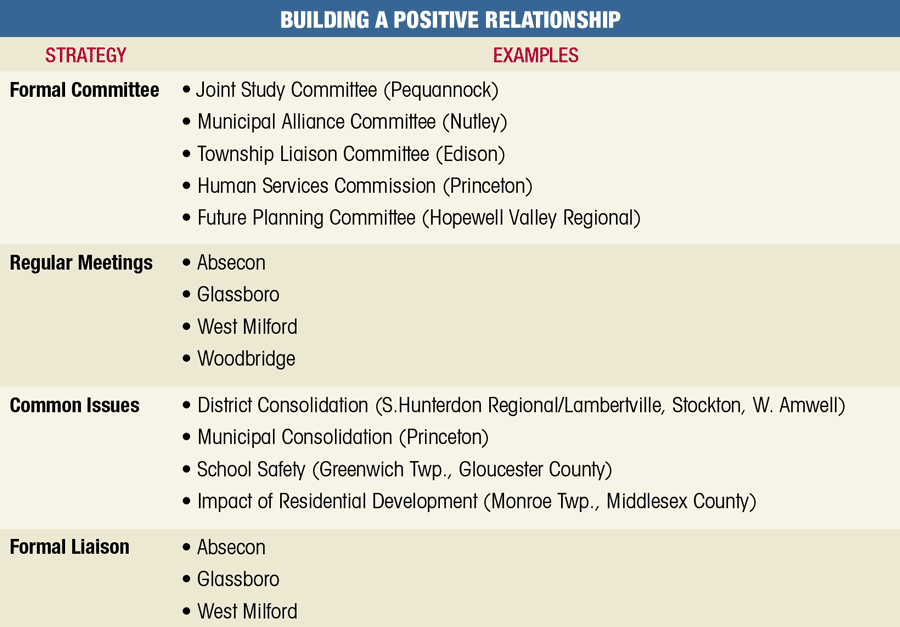School district-municipal cooperation thrives throughout New Jersey, in spite of limited state funding, local property tax burdens and the need to make ends meet in the face of the state’s 2 percent tax levy cap.
In fact, the financial strains facing public schools and local governments make dialogue and cooperation essential elements in maintaining the level and quality of services.
These were among the findings of two consecutive annual surveys conducted by the New Jersey School Boards Association and the New Jersey State League of Municipalities (NJLM). The survey results formed the basis of panel discussions, moderated by the organizations’ leaders and featuring school and municipal officials at NJSBA’s annual Workshop and the League’s statewide conference in 2014 and 2015.
“This year, our questions asked about shared services and their impact on the ability of school districts’ and municipalities to comply with the state’s 2 percent tax-levy cap,” Donald Webster, Jr., NJSBA president, explained during the 2015 presentation. Webster also serves as president of the Manchester Township Board of Education in Ocean County.
The 2015 survey, administered in August and September, queried school and municipal officials on the following topics:
- The types of shared services they engage in;
- The quality and efficiency of the shared services; and
- The impact of shared school-municipal services on the ability of both units to meet the requirements of the 2-percent levy cap.
“Because the relationship between the school board and the municipal government is critical to the success of any cooperative effort, we also asked our members about the quality of these relationships,” said Webster.
One-third of the state’s communities were represented in the survey. Not only do the responses shed light on the status of school-municipal cooperation, but they also provide instruction on how to build and improve productive relationships.
THE 2 PERCENT TAX-LEVY CAP
“In 2011, the Governor and the Legislature enacted a 2-percent tax-levy cap with no waivers and few adjustments,” said Brian Wahler, NJLM president. “The ‘hard cap’ was intended to control property-tax increases, but it also presented serious financial challenges to schools districts and municipalities, which were already struggling to maintain services with reduced or flat state aid. “The 2-percent cap resulted in a renewed focus on shared services and collaboration among local governments and the public schools.”
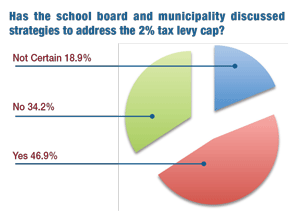 School-Municipal Cooperation: Survey Results
School-Municipal Cooperation: Survey Results
Results of the 2015 survey showed a high degree of communication about the cap and financial matters at the community level.
COMMENTS:
Almost half of survey respondents said school and municipal officials have met to discuss ways to meet the requirement of the tax-levy cap.
Over the last several years, both bodies have met to discuss living within the 2 percent cap. As a result, we have entered into many shared-service agreements with the municipality which has not only saved the district money, but enabled us to work cooperatively with each other.
Board of Education President, Passaic County
The mayor and I meet regularly to discuss ongoing issues including the tax levy, cooperative agreements and areas of shared service. However, we do not have full board meetings with representatives from the township committee.
Superintendent, Bergen County
We haven’t met specifically on the topic of the 2 percent cap, but we regularly meet to discuss ways to share and reduce or control costs.
Municipal Manager, Essex County
Both the elementary school district and the high school regional district present their budgets to the governing body, and we have a dialogue regarding changes in the budget from the previous year.
Borough Administrator, Morris County
SHARED SERVICES
Whether the focus of communications is the 2-percent tax-levy cap, or not, the vast majority of respondents (87.2%) said their school districts and municipalities share services.
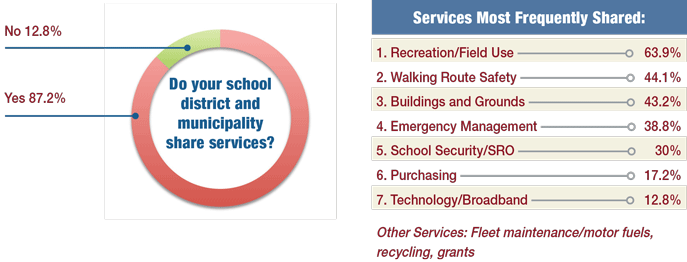 Types of Shared Services
Types of Shared Services
The shared services most frequently cited should come as no surprise to school board members and administrators: recreation/field use, walking-route safety, and buildings-and-grounds maintenance.
However, the survey results also indicated a trend toward school security, technology, sustainability-related efforts and grant-writing.
Focus on Technology
The 2015 survey placed a special focus on technology by asking school and municipal officials for examples of shared services in this area. Most respondents pointed to cooperative use of infrastructure, such as fiber optic networks and intranet, as well as the establishment of emergency alert systems.
COMMENTS on Technology:
The municipality, school district and Rowan University have shared broadband.
School Board President, Gloucester County
The borough runs ‘Rosenet,’ a fiber that connects all borough and school buildings to one another and to the internet.
Councilman, Morris County
We manage their Internet, and they ride on our fiber optic lines and provide first response when issues arise.
School Business Administrator, Monmouth County
The township broadcasts school board meetings on the public access channel… Media and messaging are coordinated, especially during emergency conditions.
Township Administrator, Morris County
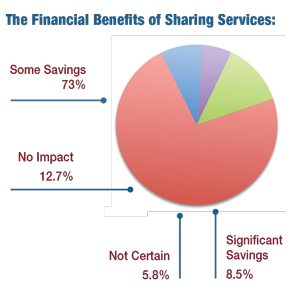 Financial Benefits
Financial Benefits
Do shared services pay off? The answer, according to the survey, is affirmative. A wide majority of respondents indicated that their communities experienced at least some savings through shared-service efforts.
In addition, over half of the respondents said that shared services helped their school district or municipality stay within the 2-percent tax-levy cap.
It’s Not All About Money:
In addition to financial savings, improved quality is a goal of shared services. Close to half of the survey respondents indicated that sharing has resulted in higher quality services. Additionally, some officials noted that cooperation was driven more by mutual goals and the welfare of the community’s children than by finances.
COMMENTS on Financial Benefits:
The township provides savings to the district by cutting large lawn areas and fields. They also provide snow plowing in the winter.
School Business Administrator, Monmouth County
We are still charged for trash and snow removal. However, it is less than we would pay if we contracted with a third-party vendor.
School Business Administrator, Burlington County
Our inter-local agreement with the regional high school for a school resource officer offsets the salary for that position.
Borough Administrator, Camden County
We have derived minimal savings, but we have enjoyed a cooperative relationship that makes our management of services and activities more efficient.
Superintendent, Morris County
Without the savings, we would have had to cut some other budget line. We do need to continue to look for savings elsewhere as many other budget lines increase each year. At some point in the near future, all options will be exhausted and the cap will affect classroom instruction.
School Business Administrator, Essex County
While some savings have been realized, collaboration with the municipality and Rowan University has yielded a value-added and positive perception within the community.
Board President, Gloucester County
The condition of the school fields has improved significantly since a cooperative effort to renovate and maintain the fields was put in place. Athletic fields on school property support school, township recreation, and local non-profit sports programs. The quality of the fields has benefited all user groups.
Township Administrator, Morris County
There has been more timely service and better working relationships between agencies. We believe a strong interagency relationship is a key to identifying other possible future services.
Superintendent, Bergen County
We have worked together on many issues related to safety, traffic, noise and environment.
Board President, Mercer County
The town has provided the same services (snow plowing, snow removal and salting) for well over 35 years. The quality has always been outstanding, and they have always responded when called.
Board President, Morris County
We have several partnerships with municipal entities to meet various needs. Not all of these partnerships are driven by budgetary concerns. For example, we partner with the municipality’s Human Services Commission to provide supplemental food on weekends and summers to our children who are food insecure. This is not at all because of the 2% cap or to save money. It’s about a shared mission in support of our neediest children, regardless of cost.
Board President, Mercer County
COST-SAVING STRATEGIES / BUILDING WORKING RELATIONSHIPS
Other Cost-Saving Tactics The 2015 survey also asked school district and municipal officials about strategies other than shared services that they have used to meet the requirements of the 2 percent tax levy cap, either cooperatively or individually. The respondents provided more than 120 examples in areas such as collective bargaining, energy management and purchasing.
Working with the 2 Percent Cap: Other Strategies
- Salary guide construction
- Health benefit cost containment
- NJSBA’s Alliance for Competitive Energy Services (ACES)
- Insurance savings
- Community partnerships
Building the Relationship:
Building positive relationships requires effort by both school and town. Survey respondents listed a wide range of strategies that have enabled them to identify mutual goals and better serve their constituents. Examples include formal school district-municipal committees; liaisons between the school board and municipal governing body; regularly scheduled meetings between the representatives of the governing bodies; and facing common issues through a united front.
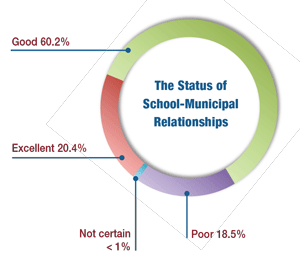 Improving School-Municipal Relations:
Improving School-Municipal Relations:
A wide majority of survey respondents characterized the relationship between their school districts and corresponding municipalities as “excellent” or “good.” According to the survey, the foundation for strong relationships was built on two-way communication, shared concerns, recognition of their shared constituencies, and respect for each other’s roles.
COMMENTS on Working Relationships:
Frequent Meetings: Regular meetings of a Joint Study Committee consisting of elected officials and management along with regular discussions among management and department heads on both sides have produced an excellent working relationship between the two entities. Township Administrator, Morris County
Open Lines of Communication: “The mayor and head of council do not hesitate to attend meetings at important times and make a real effort to understand where we are and why. I attend council meetings on occasion to present important items that I feel should be put before them. It is a small town so there is a lot of personal communication as well.”
Board President, Atlantic County
Shared Advocacy: “We have educated our municipal leaders about the underfunding of the School Finance Reform Act and the significant impact that it has on the school district. We have asked them to join us in contacting legislators regarding this issue. There has been some joint participation in meetings with legislators.”
Board President, Gloucester County
Joint Planning: “Our new superintendent has reached out to municipal leaders. We are including them all in invitations to our strategic planning sessions. We visit with them to share our budget.
Board President, Bergen County
Helping Those in Need: “The mayor has an open line of communication with the superintendent. They work collaboratively on such things as collection of school supplies for children in need, information sharing, assisting residents affected by Hurricane Sandy hit, and use of facilities.”
School Business Administrator, Ocean County
Pride in Students: “Student art displayed in municipal building; student chorus opens annual tree lighting; district events posted in borough building; superintendent updates to mayor; [hold] at least one monthly meeting.”
Superintendent, Atlantic County
Respect Boundaries: “Both town council and the board stay out of each other’s business while still maintaining an open line of communication. There has always been an open and friendly relationship during the years that I’ve been in the district, even when there were defeated budgets.”
School Business Administrator, Camden County
CRITICAL TO THE FUTURE OF OUR COMMUNITIES
Going forward, collaboration will increasingly become necessary and the norm – rather than the exception. In 2014, the leaders of the New Jersey School Boards Association and the New Jersey State League of Municipalities issued a letter pledging cooperation at the state level and encouraging it in the community.
“Today, the mutual concerns of schools and surrounding communities, ranging from school safety and security, to energy costs and preserving critical programs in the face of limited resources, will necessitate even more cooperation,” they wrote.
“The New Jersey State League of Municipalities and the New Jersey School Boards Association have worked steadfastly to improve public education and local government. Our members serve many of the same constituents and face similar challenges in terms of limited resources. For their benefit, we will continue to explore ways that our organizations can cooperate to promote creativity, cooperation and efficiency.”
